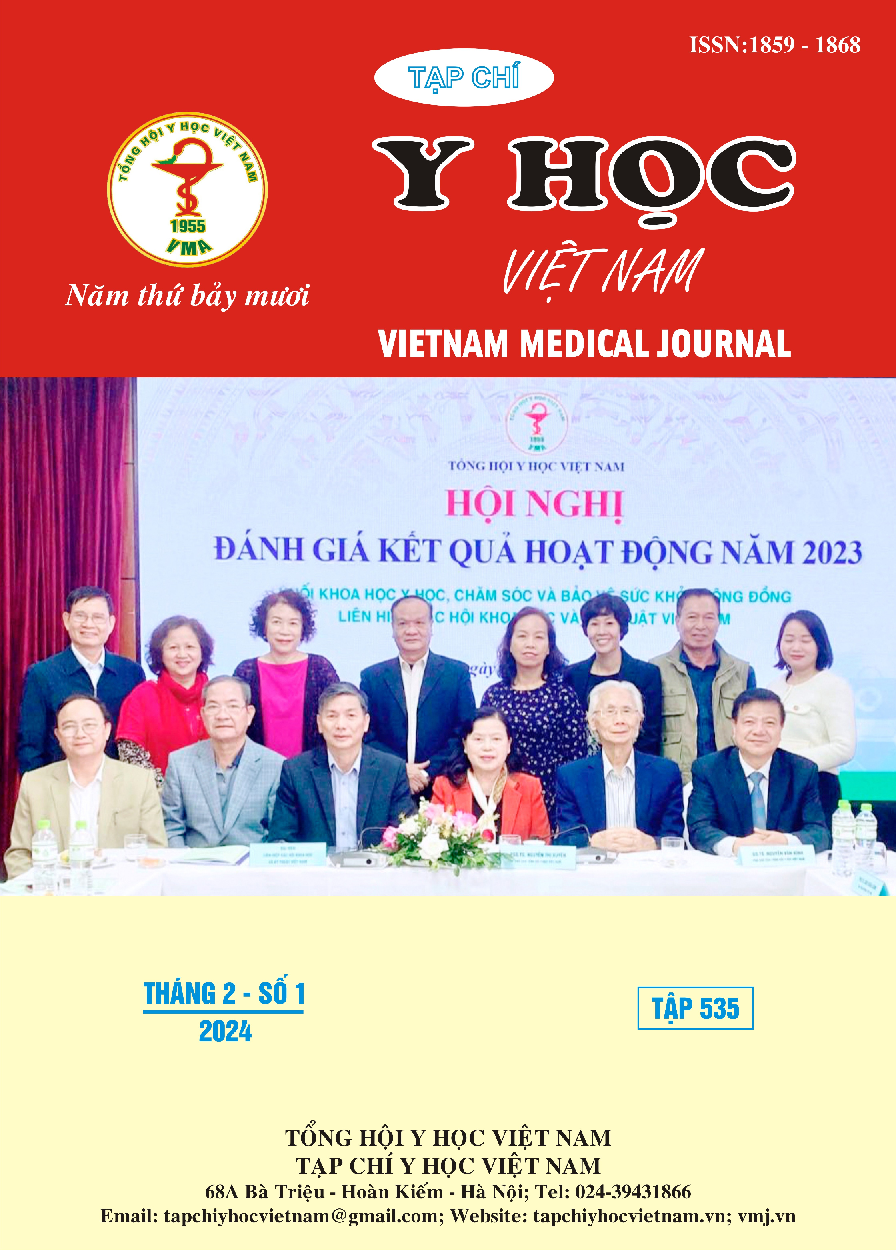TREATMENT OUTCOMES OF UPPER GASTROTESTINAL BLEEDING DUE TO GASTRIC AND DOUDENAL ULCERS AT VIETDUC HOSPITAL
Main Article Content
Abstract
Study aims: 1.Description of the clinical and paraclinical characteristics of patients with upper gastrointestinal bleeding (UGIB) due to gastric and duodenal ulcers. 2. To evaluate the effectiveness and associated factors of the treatment methods for upper gastrointestinal bleeding at Viet Duc Hospital. Patient and Method: This was a retrospective descriptive study from January 2019 to December 2022, including 278 patients diagnosed with upper gastrointestinal bleeding due to gastric and duodenal ulcers and treated at Viet Duc Hospital. Results: The mean age of the study was 59.8 ± 19.1 years, with a peak incidence in the age group of 50-79 years, a male/female ratio of 2.3. The most common occupation was white-collar workers, accounting for 42.1%. The most common clinical symptom was black stool and upper abdominal pain, accounting for 79.5%. A total of 24.7% of patients requiring intervention had symptoms of shock due to blood loss on admission. The number of patients treated with medical therapy alone was 66.3%, endoscopic intervention was 20.8%, endovascular intervention was 8.9%, and surgery was 3.9%. The initial success rate of hemostasis for the two groups of endoscopic injection and clip was 91.7% and 95.7%, respectively. The rate of recurrent bleeding in the medical treatment group was 13.5%, the endoscopic intervention group was 10.3%, the embolization group was 8%, and the surgical group was 9.1%. The most common time of recurrent bleeding was before 72 hours, accounting for 80% in the medical treatment group and 81.8% in the intervention group. The most common lesion in the surgical group was Forrest IA, IB ulcer (81.8%), location at the lesser curvature (36.4%) and posterior wall of the duodenum (36.4%), and ulcer size > 2 cm (72.7%). The most common vascular lesion in the endovascular intervention group was the gastroduodenal artery (56%). Four surgical methods were performed in succession: distal gastrectomy (63.6%), hemostatic suture with vagotomy (27.3%), and ulcer resection (9.1%). The mortality rate of the methods was: endoscopy (5.2%), endovascular intervention (4%), and surgery (9.1%). The most common postoperative complications were duodenal stump leak (27.3%), recurrent ulcer (18.2%), and recurrent bleeding (9.1%). The average length of hospital stay for the surgical method was 10.67 days. Conclusion: +Upper gastrointestinal bleeding due to gastric and duodenal ulcers is a serious complication and accounts for the highest percentage of complications in gastric and duodenal ulcer diseases. Especially in cases of ulcers on the lesser curvature or posterior wall of the duodenum, they often cause shock due to blood loss. + Current treatment is still mostly medical, with endoscopic hemostasis using injection or clip being effective for active bleeding cases. + The lesions that often occur in the group that requires embolization or surgery are usually bleeding ulcers, large in size, and located on the lesser curvature or posterior wall of the duodenum. + Surgery for upper gastrointestinal bleeding has a high mortality rate and many serious complications, the most common being duodenal stump leak, and the length of hospital stay is also longer.
Article Details
References
2. Loffroy R, Guiu B, D’Athis P, et al. “Arterial Embolotherapy for Endoscopically Unmanageable Acute Gastroduodenal Hemorrhage: Predictors of Early Rebleeding”. Clinical Gastroenterology and Hepatology. 2009;7(5):515-523.
3. Nguyễn Thị Thu Trang, Phan Quốc Hùng, Nguyễn Ngọc Tuấn (2012), "Giá trị tiên lượng của thang điểm Blatchford trên bệnh nhân xuất huyết tiêu hóa trên cấp", Tạp chí Y học thực hành, Số 852+853, tr. 192- 195.
4. Nguyễn Ngọc Tuấn, Tạ văn Ngọc Đức, Châu Quốc Sử (2012), "Kết quả kẹp clip cầm máu trong xuất huyết tiêu hóa do loét dạ dày tá tràng", Y học TP. Hồ Chí Minh, 16(11), tr. 137- 146.
5. Đào Văn Long (2016), "Xuất huyết tiêu hóa do loét dạ dày tá tràng", Bệnh học nội khoa, Nhà xuất bản Y học, tr. 38- 45.
6. Lê Thanh Dũng, Trương Bích An, Thân Văn Sỹ (2021), “Đánh giá hiệu quả của phương pháp can thiệp mạch trong điều trị chảy máu tá tràng”, Tạp chí Y học Việt Nam, 324(11), tr.136-140
7. Thái Nguyên Hưng, Phan Văn Linh (2023), “Điều trị xuất huyết tiêu hóa nặng do loét tá tràng kissing ulcer thủng vào động mạch vị tá tràng và loét dạ dày và loét dạ dày- tá tràng”, Tạp chí Y học Việt Nam, 524(3), tr.5


